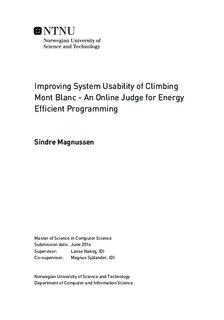| dc.description.abstract | For each release of a new smartphone model, the limits of their CPUs, so called heterogeneous multicore processors, are pushed. As a result, the usage of such processors has gained an increased interest outside the mobile market and they are now candidates for building energy efficient supercomputer architectures. The European Mont-Blanc project has for its objective to develop a high-performance supercomputer architecture, using smartphone processors, to lower energy consumption by 15 to 30 times compared to other high-performance supercomputers. The project has resulted in multiple prototypes using heterogeneous processors, and has shown promising results for future development of energy efficient supercomputer architectures.
Regarding energy efficiency, there are enormous challenges ahead for both hardware and software developers. To aid developers to create energy efficient software, Lasse Natvig started the Climbing Mont Blanc project. Inspired by other online programming competition systems, or Online Judge systems, the idea is to let programmers compete to develop energy efficient code to various programming problems. Climbing Mont Blanc is, to our knowledge, the first Online Judge focusing on energy efficiency of submitted code. However, previous user feedback has identified some components which need improved usability.
This thesis looks into improving certain usability aspects of components in the Climbing Mont Blanc system. Real-time notifications, updated feedback messages, a bulletin board, an updated user interface, and fixes of known issues have been integrated into version two of the Climbing Mont Blanc judge. A user experiment has shown that users are more satisfied with the feedback given in system version two, by a confidence value of 97.2\%. There is also a noticeable trend that the users are more satisfied with the design and the provided how-to information of the new system version. Furthermore, system usability has been continuously validated by conducting small informal user tests throughout the work on the project. | |

